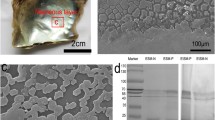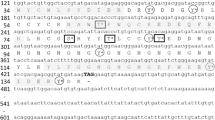Abstract
Mollusks make their shells by biomineralization using Ca2+ and CO3 2− from natural environment. In molluscan shells, two types of CaCO3 crystal which are aragonite and calcite form the species-dependent microstructures. It is believed that shell organic matrices act for control of the crystal types and microstructures. Shell of Pinctada fucata is divided into aragonitic nacreous layer and calcitic prismtic layer. In the recent years, several novel matrix components have been identified in pearl oyster shells by subsequent solubilization of the insoluble matrix, even in the nacreous layer which abounds in the data. In them, we focused our attention on a component, of which the N-terminal amino acid sequence was determined, and attempted cloning genes encoding it. As a result, several clones with typical sequence for the ORF (open reading frame) region were identified and the amino acid sequences were deduced. Further analysis of northern hybridization clarified the tissue specific expressions of the transcripts of the identified genes.
Similar content being viewed by others
References
Watabe N, Wilber K M. Influence of the organic matrix on crystal type in mollusks. Nature, 1960, 188(4747): 334
Lowenstam H A. Minerals formed by organisms. Science, 1981, 211(4487): 1126
Weiner S. Organization of organic matrix components in mineralized tissues. Integrative & Comparative Biology, 1984, 24(4): 945
Miyamoto H, Miyashita T, Okushima M, et al. A carbonic anhydrase from the nacreous layer in oyster pearls. Proceedings of the National Academy of Sciences of the United States of America, 1996, 93(18): 9657
Samata T, Hayashi N, Kono M, et al. A new matrix protein family related to the nacreous layer formation of Pinctada fucata. FEBS Letters, 1999, 462(1): 225–229
Sudo S, Fujikawa T, Nagakura T, et al. Structures of mollusc shell framework proteins. Nature, 1997, 387(6642): 563–564
Suzuki M, Murayama E, Inoue H, et al. Characterization of prismalin-14, a novel matrix protein from the prismatic layer of the Japanese pearl oyster (Pinctada fucata). The Biochemical Journal, 2004, 382(1): 205–213
Tsukamoto D, Sarashina I, Endo K. Structure and expression of an unusually acidic matrix protein of pearl oyster shells. Biochemical and Biophysical Research Communications, 2004, 320(4): 1175–1180
Gotliv B, Kessler N, Sumerel J L, et al. Asprich: a novel aspartic acid-rich protein family from the prismatic shell matrix of the bivalve Atrina rigida. ChemBioChem, 2005, 6(2): 304–314
Sarashina I, Endo K. Complete primary structure of the molluscan shell protein 1 (MSP-1) of the scallop Patinopecten yessoensis. Marine Biotechnology, 2001, 3(4): 362–369
Yano M, Nagai K, Morimoto K, et al. Shematrin: A family of glycine-rich structural proteins in the shell of the pearl oyster Pinctada fucata. Comparative of Biochemistry and Physiology Part B, 2006, 144(2): 254–262
Katoh-Fukui Y, Noce T, Ueda T, et al. The corrected structure of the SM50 spicule matrix protein of Strongylocentrotus purpuratus. Developmental Biology, 1991, 145(1): 201–202
Katoh-Fukui Y, Noce T, Ueda T, et al. Isolation and characterization of cDNA encoding a spicule matrix protein in Hemicentrotus pulcherrimus micromeres. The International Journal of Developmental Biology, 1992, 36(3): 353–361
Brandhorst B P, Davenport R. Skeletogenesis in sea urchin interordinal hybrid embryos. Cell and Tissue Research, 2001, 305(1): 159–167
Peled-Kamar M, Hamilton P, Wilt F H. Spicule matrix protein LSM34 is essential for biomineralization of the sea urchin spicule. Experimental Cell Research, 2002, 272(1): 56–61
Harkey M A, Klueg K, Sheppard P, et al. Structure, expression, and extracellular targeting of PM27, a skeletal protein associated specifically with growth of the sea urchin larval spicule. Developmental Biology, 1995, 168(2): 549–566
Raman V, Andrews M E, Harkey M A, et al. Protein-DNA interactions at putative regulatory regions of two coordinately expressed genes, mspl30 and PM27, during skeletogenesis in sea urchin embryos. The International Journal of Developmental Biology, 1993, 37(4): 499–507
Author information
Authors and Affiliations
Corresponding author
Rights and permissions
About this article
Cite this article
Nogawa, C., Obara, M., Ozawa, M. et al. Characterization of organic matrix components of pearl oyster, Pinctada fucata and their implications in shell formation. Front. Mater. Sci. China 2, 156–161 (2008). https://doi.org/10.1007/s11706-008-0026-4
Received:
Accepted:
Published:
Issue Date:
DOI: https://doi.org/10.1007/s11706-008-0026-4




